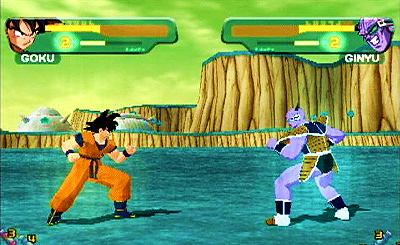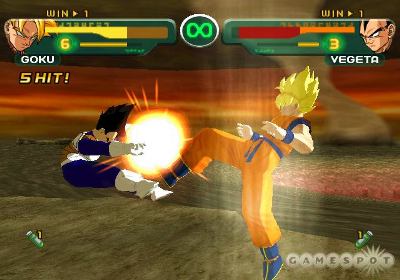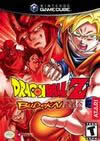
Dragon Ball Z: Budokai
Reviewed By: Matt McFarland and John Wade, IV
VOLUNTEER GUEST REVIEWER
GAME TECH INFO
Computer Platform: PlayStation II And Gamecube
Produced by: Atari
Price Range: $21-30
Learning curve time: 1-30 min.
Age level: Teens
ESRB Rating: T (Teen)
|
Overall Rating:     
Genre: Fighting
Christian Rating: 3 of 5
(some objectionable elements)
Gameplay: 4 of 5
(good)
Violence: 3 of 5
(mild)
Adult Content: 5 of 5
(none)
Long
have fans of Dragon Ball Z awaited a video game that is worthy of the series.
There have been many attempts, but all have fallen short until Dragon Ball
Z: Budokai. And while it is very true to the series, it still only comes
close to being a great game.
Gameplay
At first glace this game seems like a typical fighting game, and is quite
fun on its own. One of the features that make it stand apart from other
games is the burst zone, which happens when two opponents do a certain
move at the same time and they enter into a sequence where they fight
very fast for a short period. In order to win, you must move the analog
sticks in a circle, and the fastest person connects a hit. Budokai's story
mode covers the first three sagas of DBZ: The Saiyan saga, the Namekian
Saga, and last but not least the Android saga. Each saga contains around
10 episodes and a few unlockable ones after it is completed. I applaud
the developers for the amount of detail contained in the story mode, as
is very faithful to the anime. However, if you put the difficulty on very
easy it can be beat almost too quickly. There is also the standard “versus”
duel mode where you can either fight a against the cpu or a friend. Also,
there is a world tournament mode with three levels of difficulty (only
one is open at the beginning, the other two must be purchased). Winning
the tournament earns you money to buy skills to customize your character's
moves. A practice mode is also included so that people can try out the
moves that are earned, but it's not as in-depth as say, Virtua Fighter
4. There is also a quirky survival mode named “Legend of Hercule” (complete
with it's own title screen) where you are the World Martial Arts Champion
(and World Class Joke) Hercule, and you must defeat the Z- fighters and
Cell in the Cell games. In an interesting twist, each match has its own
certain conditions. What most DBZ fans will like though, is the capsule
system. Each fighter has a certain number of capsules that can be earned
through story mode or purchased in Mr PoPo's Capsule Shop. With capsules,
you can make a custom character that has more moved than the default version
of the character, and there is a strategic element to it in that you have
a certain amount of slots that you are allowed. However, some of the capsules
are just too powerful, such as the senzu bean which allows complete recovery
of your life bar if defeated. While customizing a character can be fun,
it can also lead to some rather unbalanced characters.
The controls take some getting used to, but each move is very easy to
perform once you get used to it. However, it does get irritating that
there is no “instant” special moves (like Street Fighter). For example,
to perform Goku's famous Kamehameha wave you have to punch four times
and press the “Ki blast” button.

Graphics
The graphics, while certainly not top notch, are still pretty good. The
developers actually reconstructed the opening intro to the series, and
each cut scene looks like a 3d version of the show. The only real complaint
is that the beginning sequence seems to move slower than its animated
version.
Adult Content
None.
Violence
Violence is a major part of the Dragon Ball series, as each saga usually
contains a number of battles between good and evil, and are usually fought
to the death. Characters use martial arts attacks and energy blasts to
pound each other until ones life meter is depleted. In the actual game,
when you knock a character out he simply falls to the ground. However,
in the story mode, which again follows the show almost perfectly, there
are a number of grisly scenes which includes three important characters
having holes blown straight through their chests by energy beams (and
you can see through the holes), and another character rams his own fist
into his chest to critically wound himself before he switches bodies with
another character.
Content
Goku, one of the main characters of Dragon Ball Z, is a very innocent
and noble man. His original purpose in life was to destroy planet Earth,
but he made a decision to stand up for Earth and protect it. He also has
a strong sense of family values, and is self sacrificial. He has a lot
of qualities that are admirable and should be taught to everyone. However
not all of the characters are as admirable as Goku. Dragon Ball Z: Budokai
contains a lot of violence, and many characters die (but are later brought
back with wishes from Dragon Balls). Also, the issue of drawing energy
from Ki (from the Chinese Chi) may disturb some people, as would the fact
that Earth is “protected” by an alien named Kame (which is a mispelling
of the Japanese word for “god”). The issue of the afterlife is also addressed
in a manner that is not according to biblical standards, as characters
can be resurrected from the dead using wishes from Dragon Balls. Christians,
however, know that resurrection come s from God, not by making wishes.
Also, at the end of the Cell saga Goku encourages Gohan to be stronger
by feeding off of his anger (although there are numerous times throughout
the game where Goku displays the character of a great role model). The
common theme of the game may also me more serious than a child can handle,
as life and death are frequently mentioned in the story mode.

Ultimately, Dragon Ball Z: Budokai is a fun game to play for a while,
and customizing characters and unlocking capsules and earning Dragon Balls
provides some extra gameplay. However the whole Saiyan pride, Dragon Balls,
constant violence, death, and Ki attacks often left me with a bad taste
in my mouth. Ultimately, the choice is with the person buying the game
whether they be a older fan of the series or a parent buying the game
for a child. If you're part of the latter, rent the game and sit down
with your child and watch them play it. Do the ideas that the game give
out offend you or do you want your children learning from these false
sense of morals? Perhaps when you see something in the story mode that
is not a good moral practice, you can pause the game and have a discussion
with your child about what the right thing was to do, and what they would
have done in the same situation. Sometimes the problem is not the content
of the game, but whether or not you're effectively teaching your child
about what is right and wrong in the game.
Year of Release—2002
Disclaimer: The opinions expressed in this Christian Spotlight review are those of the reviewer (both ratings and recommendations), and do not necessarily reflect the opinions of Films for Christ or the Christian Answers Network.
Christian Spotlight Guide2Games is part of Christian Answers. Copyright © Films for Christ. • “Christian Spotlight’s Guide to Games” and “Guide2Games” are service marks of Films for Christ.
 | 








